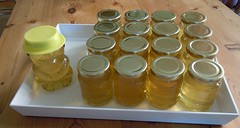I’ll admit it, if I can figure out a way to keep myself healthy (or looking good) without using drugs or man-made chemicals which could harm myself or my environment, I’ll do it. It’s not a quick process, but the more I learn, the less I buy from stores and the more I make myself. One of my best buddies in my goal towards healthy living naturally is honey. Raw local honey specifically.
While you can buy honey at the grocery store, keep in mind that it’s quite possible that its been adulterated, pasteurized and most likely isn’t made from bees in your area. Which is important. A good local raw honey is a wonderful thing. I tend to get mine from farm stands or markets or from local apiaries (bee keepers). If I had the room I would definitely have a hive or three. Because local raw honey is a miraculous article.
Honey doesn’t go bad. Its one of the few foods in nature that defies the entire “If it doesn’t go bad, it’s not food” rule. There are always outliers to the rules you know. Honey can crystallize in cold, but warmed up it becomes liquid again. But besides being a sweeter, honey is so much more. Raw honey can be used both inside and out to not only taste good, but to heal you.
As with any food, make sure that you are not allergic before using. Also do not give or use honey on a child younger than a year old. Honey can contain botulinum endospores which a young child’s digestive track cannot handle.
Topically, honey has strong anti-bacterial, anti-microbial anti-septic and anti-fungal properties. So its great to use on burns, wounds and skin infections to help in the healing process. Because its thick, honey provides a protective barrier between the skin infection and the air. It also contains some hydrogen peroxide which releases slowly, killing germs in the wound. Other components of honey help to speed up growth of healthy tissue. Patients who were treated with honey also experienced less pain and scarring.
Honey is also a wonderful help in relieving acne. Simply rubbing honey on to the affected areas of the skin and leaving it there for 15 minutes before washing it off. Apply daily until acne clears up.
Honey is also a great moisturizer and can be used for both skin and hair treatments. Honey attracts water and can help both skin and hair retain that moisture. Mix it up with some olive oil for a luxurious hair treatment. Be sure to rinse it out well.
I’ve used local, raw honey to stop my hay fever. After a trip to Hartford Connecticut about five years ago during spring (Hartford is called the Allergy Capitol for a reason), I began suffering from spring allergies. A few years ago, I started using raw honey in my tea and cooking and the next year I haven’t had an allergy attack since. Even in the years that everyone says its horrible, I have been allergy free.
Internally, honey has some other amazing health benefits, some of which are sure to be already on many people’s radar.
Ever put some honey and lemon in tea when you had a sore throat? Its one of the areas that raw honey is amazing at. Additionally, there is some evidence that honey is helpful in increasing your anti-oxidant intake since it encourages the growth of the good bacteria in your gastrointestinal tract.
There are many varieties of honey, some of which are better at treating specific conditions. Manuka honey (honey made from the Manuka bush), is especially potent as a wound treatment since it has strong antibacterial qualities.
Related articles





Just a question about raw honey and allergies – I have heard that if one consumes honey from local bees, it includes sample pollen. Consuming this is said to help the body to build an immunity and lessen allergies.
In order for it to be effective, one that one should consume honey that was taken from bees less than twenty miles from your house.
I have access to a health food store within walking distance 🙂 but the raw honey there just hits the 20 mile mark. I have a person I purchase beeswax from who is located about 10 miles away, but is much less accessible.
First – are the above statements true, and if so, how local should the honey be for it to be effective in stinging allergies?
Thanks,
April
Definitions of the word local as it pertains to honey seems to range from “next door” to 50 miles down the road. The main concern is that the honey be produced in the range of your local allergens. Most of the information I was able to bring up agreed that up to 50 miles away was still considered local for the purpose of relieving allergens.
For anecdotal purposes, I have consumed local honey from as far away as 77 miles (Berkeley Springs, WV) and 123 miles (Seaford, DE) without noticing an issue with my allergies. Of course those were special honeys. Most of my honey is bought from a farm about 25 miles away as well as at my farmer’s market which considers anything grown within about 50 miles to be local.
[…] the best ways is to drink chamomile tea, add a tablespoon of honey. Mouse here for Related LinksRaw Honey Has Both Internal and External Benefits This entry was posted in HEALTHCARE and tagged benefits of honey, health benefits of honey, […]